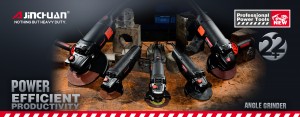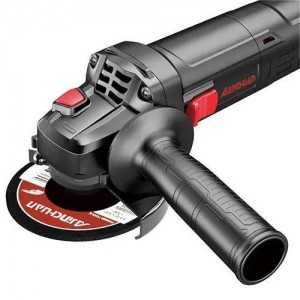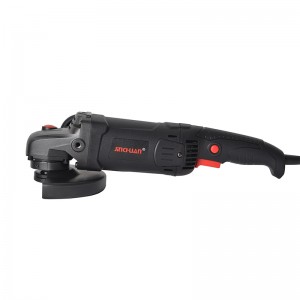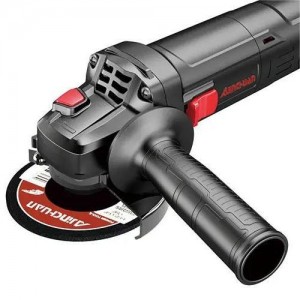In recent years, a notable trend has been taking shape in the global tool market – the group of professional DIY users is expanding at an unprecedented rate. These intermediate groups, who are neither pure amateurs nor professional craftsmen, are driving structural changes in the demand for power tools such as diagonal grinders. They pursue professional-level performance while maintaining a clear understanding of price sensitivity. This dual demand is reshaping the product direction and technological development path of the entire Angle grinder market.

First, the Rise and Characteristics analysis of the professional DIY user group
The rise of professional DIY users is not accidental but the result of the combined effect of multiple socio-economic factors. The increase in home time, the expansion of channels for skill learning, and the pursuit of personalized living Spaces have jointly given rise to the growth of this unique consumer group.
From the perspective of population structure, middle-aged and young people aged 25 to 55 constitute the main force of professional DIY users, among whom 70% have stable full-time jobs and possess certain purchasing power and time flexibility. Unlike traditional amateurs, they are no longer content with simple home repairs but venture into furniture making, courtyard renovations, and even small-scale decoration projects. These tasks put forward professional-level requirements for the performance of Angle grinders. Survey data shows that this group uses Angle grinders on average 3 to 5 times a month, with each operation usually lasting 1 to 3 hours, which is much higher than the usage frequency of ordinary DIY users.
Skill level is the core indicator to distinguish professional DIY users. 65% of professional DIY users have systematically learned tool usage skills through online tutorials and community courses, and are proficient in handling medium-difficulty tasks such as metal cutting and stone grinding. This skill improvement directly translates into the ability to identify tool performance. They can clearly distinguish the differences among various Angle grinders in terms of rotational speed stability, vibration control, and heat dissipation performance.
At the consumer psychology level, professional DIY users exhibit the characteristic of “quality pursuit under the orientation of pragmatism”. They are willing to pay a premium for core performance, but remain rational about the non-essential features added by the brand. Data shows that when such users purchase Angle grinders, the average decision-making cycle is 14 to 21 days. They will compare 3 to 5 product options and pay particular attention to hard indicators such as motor power, speed range, and safety protection.
Second, the core application scenarios that drive the sharp increase in demand for Angle grinders
The diverse project demands of professional DIY users have continuously expanded the application scenarios of Angle grinders, thereby driving an explosive growth in market demand. These scenarios not only involve the deepening of traditional fields but also give rise to many emerging application directions.
The demand in the field of metal processing is the most stable. From self-made steel structure brackets to the refurbishment of old metal parts, professional DIY users have higher requirements for the cutting accuracy and efficiency of diagonal grinders. Processing steel plates with a thickness of 3-8mm has become a common demand, which requires Angle grinders to have a power output of over 1200W and stable speed control capabilities. It is worth noting that the proportion of metal polishing operations has increased by 47% in the past two years, driving the demand for the speed regulation function of diagonal grinders – stepless speed regulation from 8,000 to 12,000 revolutions per minute has become the mainstream choice.
The processing of stone and concrete constitutes the second largest application scenario. In projects such as courtyard hardening and wall repair, Angle grinders are often used for stone cutting and surface treatment. This type of working environment generates a lot of dust, which has driven users to pay more attention to dust-proof design and durability. Data shows that the average replacement cycle of Angle grinders used in stone processing is 23% shorter than that of those only used in metal processing. This directly prompts professional DIY users to pay more attention to the sealing performance of bearings and the design of heat dissipation systems.
Emerging creative production scenarios are growing rapidly. From metal art ornaments to the production of metal connectors for custom furniture, the application of Angle grinders in the creative field has given rise to special demands for lightweight and controllability. This type of user is more inclined to choose lightweight models weighing 1.5 to 2 kilograms. At the same time, they require a reasonable body balance design to enable long-term handheld operation without easy fatigue. Surveys show that creative production users change their tools 35% more frequently than traditional users, and they are more willing to try new products with innovative designs.

Third, the art of balancing high performance with high cost performance
The core demand of professional DIY users lies in how to achieve the performance closest to professional level within a limited budget. This demand has driven Angle grinder manufacturers to seek a delicate balance between technological innovation and cost control, giving rise to a series of targeted product improvements.
The advancement of motor technology has become the key to balancing performance and cost. The new series-excited motor, by optimizing the winding design, reduces energy consumption by 18% while maintaining a power output of 1400W. This means that under the same battery capacity, the battery life of the wireless Angle grinder is extended to over 45 minutes. More importantly, the manufacturing cost of this motor only increases by 7% compared to traditional models, significantly lowering the price threshold for high-power models.
The application of materials science provides new ideas for improving cost performance. The casing is made of high-hardness aluminum alloy instead of some steel, which reduces the weight by 15% while maintaining the strength of the body and cutting the material cost by 12%. The application of powder metallurgy technology in key wear components such as gear sets can extend the service life to 1.8 times that of traditional processes, effectively enhancing the comprehensive value ratio of the product.
The popularization of intelligent control technology has not significantly increased costs. The built-in overload protection chip can respond to abnormal loads within 0.3 seconds to prevent motor burnout. This protection mechanism only increases the cost of the entire machine by 3% to 5%, but it can significantly reduce the user’s maintenance expenses. Some models are equipped with a soft start function, which not only enhances operational safety but also reduces the impact on the power grid, making it particularly suitable for users of old residential buildings.
Modular design is changing the criteria for evaluating cost performance. The replaceable carbon brushes, easy-to-disassemble gearboxes and other designs enable professional DIY users to complete basic maintenance by themselves, reducing the usage cost by more than 30%. Although this design concept increased the manufacturing cost by 10% in the initial stage, it ultimately reduced the total cost for users by extending the effective service life of the product.
Fourth, safety and humanized design have become the new focus of market competition
As the operational complexity of professional DIY users increases, the safety performance and humanized design of Angle grinders are transforming from secondary factors to core competitiveness. These users not only attach great importance to security guarantees but also pursue efficient and comfortable usage experiences, driving product design towards a more refined direction.
The application scope of active safety technology is constantly expanding. In addition to the traditional leakage protection, the new generation of Angle grinders are generally equipped with a reverse braking system, which can stop the grinding wheel rotation within 0.5 seconds when a jam occurs, reducing the risk of accidental injury by more than 60%. The adjustable safety shield is no longer a simple rotating structure but adopts a multi-position positioning design, which can adapt to the operation requirements at different angles while maintaining the best protective effect.
Innovations in ergonomics have significantly enhanced the operational experience. The asymmetric handle design takes into account the difference between left and right hand users, and is made of anti-slip rubber material, which increases the grip stability by 40%. The optimized adjustment of the center of gravity of the body has reduced the arm fatigue of users when working vertically by 25%, which is particularly important for professional DIY users who work for an average of 1.5 hours per session.
Significant progress has been made in heat dissipation design and noise control. The new type of turbine cooling fan can keep the body temperature below 55℃. Even if it works continuously for one hour, it will not experience overheating protection and shut down. The application of noise reduction technology has reduced the working noise from the traditional 105 decibels to 92 decibels, minimizing damage to hearing and also reducing neighborhood disturbances.
Intelligent auxiliary functions are beginning to gain popularity. The battery level indicator light has been upgraded from a simple two-level red and green display to a four-level precise display, allowing users to arrange their work pace more reasonably. Some models are equipped with a working time recording function, which helps users understand the replacement cycle of consumables and avoid safety hazards caused by excessive wear of grinding wheels.

Fifth, future market development trends and technological evolution directions
The continuous expansion of the professional DIY user market is guiding the Angle grinder technology to develop in a more precise, intelligent and environmentally friendly direction. These trends not only reflect current demands but also foreshadow the innovative paths of future products.
The wireless process will be accelerated. With the increase in the energy density of lithium batteries, wireless Angle grinders with voltages above 20V can now meet 80% of professional DIY operation demands. It is expected that the market share of wireless models will rise from the current 35% to 55% in the next three years. The breakthrough in fast charging technology – achieving an 80% charge within 30 minutes – will further alleviate users’ concerns about battery life.
Intelligent functions will be popularized from high-end to mid-range. By connecting to a mobile phone APP via Bluetooth, functions such as work data recording, maintenance reminders, and even fault diagnosis are being extended from professional-level products to mainstream models. This kind of intelligence is not merely a simple accumulation of functions, but rather a practical solution to users’ pain points – for instance, automatically recommending speed parameters based on the working materials, enabling even novices to achieve professional-level results.
Environmental protection performance will become a new competitive dimension. The application of brushless motors not only enhances energy efficiency but also reduces the waste generated from carbon brush replacement. The proportion of recyclable materials in fuselage manufacturing has risen from 5% to 15%, and some brands have committed to increasing this ratio to 30% by 2027. The surface coating technology with low VOC (volatile organic compounds) also meets users’ pursuit of a healthy home environment.
Customized and scenario-based products will come to the fore. Specialized Angle grinders optimized for different scenarios such as woodworking, metal processing, and stone treatment will gradually replace “universal” products and become the mainstream in the market. The improvement of the accessory ecosystem – from grinding wheels of different grit sizes to dedicated protective covers – enables an Angle grinder to adapt to various operation requirements by simply replacing accessories. This precisely meets the actual needs of professional DIY users who pursue multi-functionality with a single machine.
The expansion of the professional DIY user group is not only a change in market size, but also an innovation in consumption concepts. They are driving the Angle grinder to transform from a simple tool into a comprehensive solution that is “reliable in performance, reasonable in price, safe in use and comfortable in experience”. This transformation not only reflects users’ pursuit of a quality life, but also indicates that the tool industry will achieve sustainable development through the positive interaction between technological innovation and user demands. For those products that can accurately grasp this trend, the growth of the professional DIY market will bring unprecedented development opportunities.
Post time: Oct-21-2025

